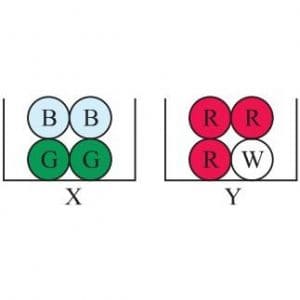I’ll come clean straight away… probabiliy is my favourite maths topic. Sad, hey? I’m not too good at drawing shapes or using a compass, but I’m pretty good at Probability, and I like it, and hopefully after reading this section, you will too!
What is ProbabiIity?
● Probability is the Iikelihood or chance of something happening.
● And that something can be pretty much anything – from something boring like getting a head when you toss a coin, to something much more interesting, like the probability of a £300 million space rocket returning safely from it’s mission.
● We use probabilities every single day in the decisions we make without even knowing it.
● the tools. I am going to arm you with in this section will hopefully enable you to understand and enjoy probability through to A Level and beyond that’s the plan, anyway.
the Lingo you need:
Experiment – now, this doesn’t necessarily mean rats and men in lab coats, it just means something is happening, and someone else is observing what happens.
Outcomes – these are all the different things that could happen in a probability experiment. One question you must always ask yourself is: “is every outcome equally likely to happen?”
Event – this just means the particular outcome or outcomes we are interested in.
the most important maths formula you will ever learn…
Here it comes…

P(event) – this is just a quick way of writing: “the probability of an event happening”. e.g. P(rain on Wednesday) means “the probability it will rain on Wednesday”
the number of ways the event could happen – you have to carefully count up all the different ways there are of the event you are interested in actually occurring
the total number of possible equally likely outcome – this is the hardest and most important bit. You must carefully count up all the total possible things that could happen, but you must remember that they must all be equally likely!
And when you get your answer using the formula, it will be a fraction, and you should simplify it you can!
And everything you need to know about probability comes from this formula!
Now, we will discover all the important probability concepts, using a few examples…
Big Example 1 (includes Question 1 to 4)
Imagine, for some reason, someone has put each of the 26 letters of the alphabet on identical tiles and chucked them in a bag. This person then decides it would be fun to get you to close your eyes and pick tiles out of this bag. You are not so sure, but you decide to give it a go as it will be a good way of learning about probability.
Question 1: What is the probability of picking out a vowel?
Well, let’s use our formula:

Question 2: What is the probability of picking out a letter?
the answer might be obvious, but let’s see why:

Rule 1: If something has a probability of 1, it is CERTAIN to happen
Question 3: What is the probability of picking out a number?
Again, it’s easy, but look why it works!

Rule 2: If something has a probability of 0, it is IMPOSSIBLE
Rule 3: All probabilities lie between 0 and 1, so if you find yourself with a negative answer, or something like 2.4, then you have done something wrong!!!
Question 4: What is the probability of picking the letter A, given that your ‘Friend tells you the tile in your hand is a vowel?
Now, believe it or not, this question is bordering on being A Level, but our good old ‘Formula still

Q5. A letter is chosen at random from the word ‘ASSASSINATION’. Find the probability that letter is (i) a vowel (ii) a consonant.
answer:
There are 13 letters in the word ASSASSINATION.
(i). There are 6 vowels in the given word.
(ii). There are 7 consonants in the given word.
Q6. A single letter is selected at random from the word ‘probability’. Find the probability that it is a vowel.
answer:
Possible outcomes
n(S)=11
Event of selection of vowels
n(E)=4
Probability of selection of a vowel





